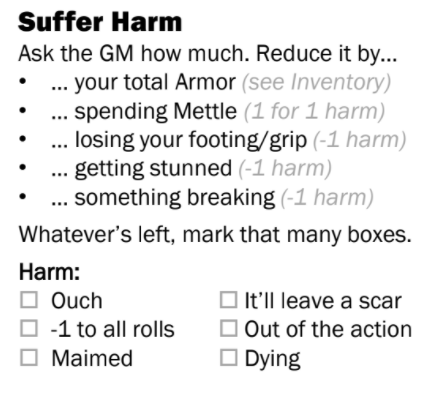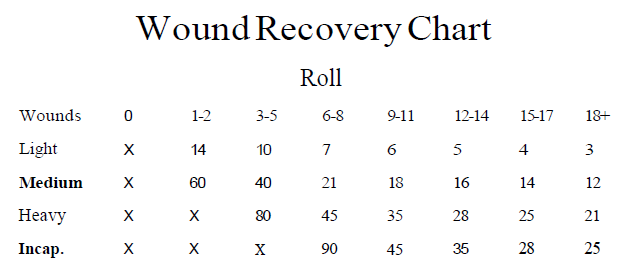I’m quite pleased with the harm system in Defying Danger.
Harm rolls are always 3 x d6, keeping the highest, middle, or lowest die. You adjust that number up or down based on size difference (a large monster deals +1 damage to a human-sized foe; a human-sized PC does -1 damage to a large foe) and force parity (+1 for outnumbering your foe, -1 if they outnumber you; +2 if you can swarm them; -2 if they can swarm you).
When PCs suffer harm, they use this procedure:

(Mettle is the Warrior class’s expendable resource. It can also be spent to increase a roll, or for character-specific benefits. A Rogue has Cunning that can do much the same thing. Wizards have Power, but can’t spend it to reduce harm… they have magical protection as one of their gear options instead.)
Monster attacks can have tags like forceful that mean the damage typically knocks you down, sends you flying, breaks, stuff, etc.
So if I’m a Warrior with 2 Armor, and I get walloped by an ogre that deals best-of-3d6 forceful damage (+1 for size), I’m likely to take, oh, let’s say 5 damage and get sent flying. My Armor drops that to 3 damage, and I might choose to spend 1 Mettle and lose my grip on my weapon, reducing that to 1 damage. I mark “[x] Ouch.”
I dust myself off, draw my backup weapon, and rush in again, but I biff my roll, and get smashed again. This time, the GM rolls 7 damage and they described the attack as an overhand smash, so I’m definitely losing my footing. Armor drops that 5 damage, I spend 1 more Mettle to bring that down to 4, and say that my shield breaks to reduce it to 3. I have to mark 3 more boxes, so I mark “[x] -1 to all rolls” and “[x] it’ll leave a scar” and… crap, now what? I could reduce that harm by 1 and be stunned. I could marked “[x] maimed” (broken arm?) but keep fighting. I could mark “[x] Dying” (fractured skull?) but somehow stay in the action. Or I could mark “[x] Out of the action.” If I’ve got friends nearby, maybe being stunned or out of the action is the right choice? Otherwise, I’m probably going to keep fighting for now with that broken arm.
Point is, big damage is scary, but armor helps and you’ve got a combination of metacurrency and fictionally interesting ways to mitigate it. When it starts to get real bad, you’ve got interesting decisions to make. And even if the foe is relatively weak (dealing the lowest of 3d6 harm) there’s still a chance that they roll high and cause you some serious trouble.

